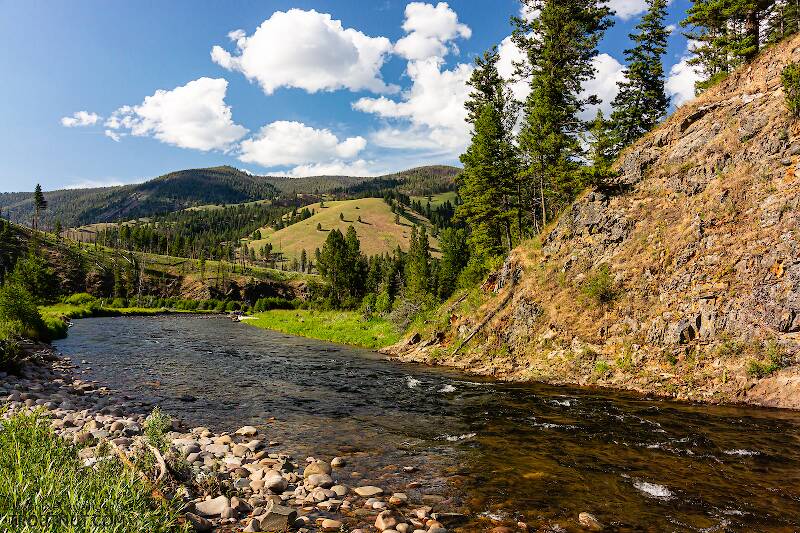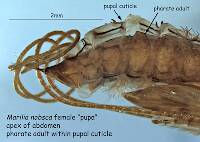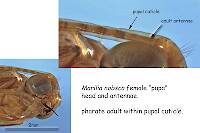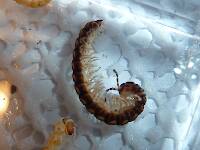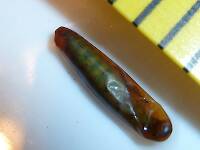
Blue-winged Olives
Baetis
Tiny Baetis mayflies are perhaps the most commonly encountered and imitated by anglers on all American trout streams due to their great abundance, widespread distribution, and trout-friendly emergence habits.
Featured on the forum

This is the first of it's family I've seen, collected from a tiny, fishless stream in the Cascades. The three species of this genus all live in the Northwest and are predators that primarily eat stonefly nymphs Merritt R.W., Cummins, K.W., and Berg, M.B. (2019).

Troutnut is a project started in 2003 by salmonid ecologist Jason "Troutnut" Neuswanger to help anglers and
fly tyers unabashedly embrace the entomological side of the sport. Learn more about Troutnut or
support the project for an enhanced experience here.
Goose
Posts: 77
Posts: 77
Goose on Sep 13, 2006September 13th, 2006, 1:47 am EDT
Jason, first of all, great photos of the caddis larva. Questions: Using Fontaine's emerger patterns, would you tie this fly with a green body, dark throax, and tan or brown antron for the sheath (bubble)? Is the brown case the green sedge is in what we're trying to simulate with the antron bubble? I hope these questions are understandable. Thanks, Goose
Troutnut on Sep 13, 2006September 13th, 2006, 5:05 am EDT
Well, the emerger is going to be a pupa rather than a larva, so you would want to imitate something that looks like this specimen.
There's one important feature you can't see in my pictures: just when it's about to emerge, the fly supposedly secretes some air bubbles underneath the outer skin of the pupa to buoy it to the surface. I haven't seen this myself, but I trust LaFontaine's observations. The air bubbles give it a sparkly look, which he started to imitate with the antron bubble.
His rationale was that the structure of the yarn traps little air bubbles in the same way as the actual pupa, so the sparkling would come from the bubbles rather than the yarn itself. This strikes me as a little strange, since I can't get the patterns to trap much air and the sparkling in the yarn itself seems much more prominent.
Since the yarn is really meant to help imitate bubbles trapped under the skin of the body, I think it should be roughly the same color as the body. Trial and error might prove me wrong, but there's no apparent imitative reason to make the colors different.
I would tie the imitation with a brown/tan thorax and wing pads, and a green body and green antron sheath. I haven't fished a really good Rhyacophila emergence so I don't know how well this would work, but those would be my choices based on looking at the insect.
There's one important feature you can't see in my pictures: just when it's about to emerge, the fly supposedly secretes some air bubbles underneath the outer skin of the pupa to buoy it to the surface. I haven't seen this myself, but I trust LaFontaine's observations. The air bubbles give it a sparkly look, which he started to imitate with the antron bubble.
His rationale was that the structure of the yarn traps little air bubbles in the same way as the actual pupa, so the sparkling would come from the bubbles rather than the yarn itself. This strikes me as a little strange, since I can't get the patterns to trap much air and the sparkling in the yarn itself seems much more prominent.
Since the yarn is really meant to help imitate bubbles trapped under the skin of the body, I think it should be roughly the same color as the body. Trial and error might prove me wrong, but there's no apparent imitative reason to make the colors different.
I would tie the imitation with a brown/tan thorax and wing pads, and a green body and green antron sheath. I haven't fished a really good Rhyacophila emergence so I don't know how well this would work, but those would be my choices based on looking at the insect.
Jason Neuswanger, Ph.D.
Troutnut and salmonid ecologist
Troutnut and salmonid ecologist
Quick Reply
Related Discussions
Topic
Replies
Last Reply
8
Feb 12, 2009
by Troutnut
by Troutnut

